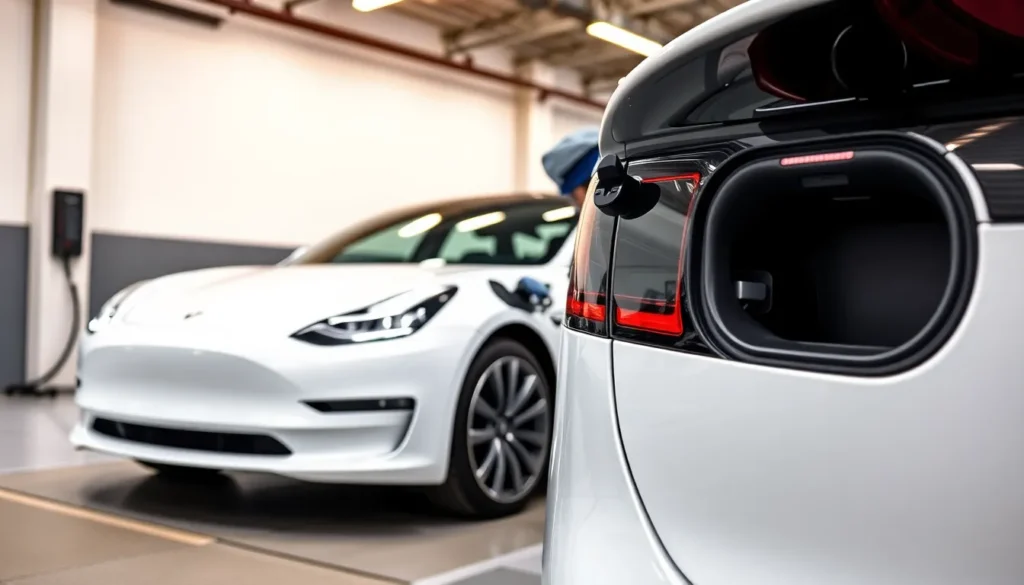Table of Contents
ToggleTesla owners know the thrill of driving a high-tech electric vehicle, but what happens when the battery starts to lose its spark? Just like a smartphone that needs a recharge, a Tesla battery replacement can be a shocking expense. With prices that might make you feel like you’re buying a small island, understanding the costs involved is crucial for any savvy driver.
But fear not! This article dives into the nitty-gritty of battery replacement costs, helping drivers navigate the sometimes murky waters of electric vehicle maintenance. Whether you’re contemplating a replacement or just curious about the price tag, knowing what to expect can save you from a jolt of sticker shock. Buckle up as we break down the costs, so you can keep your Tesla running smoothly without breaking the bank.
Overview of Tesla Batteries
Tesla batteries are crucial for the performance and longevity of electric vehicles. Understanding the types of batteries and their lifespans helps owners make informed decisions regarding maintenance and replacement.
Types of Tesla Batteries
Tesla primarily uses lithium-ion batteries in its vehicles. These batteries are designed for efficiency and longevity. Model S, Model 3, Model X, and Model Y utilize different configurations, but they all rely on this advanced technology. Different battery capacities exist, with options ranging from 50 kWh to over 100 kWh. Each type caters to specific range and performance requirements for various driving needs.
Lifespan and Performance
Battery lifespan varies based on driving habits, charging patterns, and environmental factors. Generally, Tesla batteries last between 300,000 to 500,000 miles or 8 to 15 years. Consistent charging and maintaining optimal temperature conditions can enhance performance. Many users report minimal degradation for several years, which sustains vehicle efficiency. Regular monitoring of battery health can also help catch issues early, improving overall vehicle reliability.
Factors Influencing Replacement Costs

Battery replacement costs for Tesla vehicles depend on several factors. Understanding these aspects is crucial for Tesla owners facing potential replacements.
Tesla Model Variations
Tesla models present varying battery replacement costs. The Model S, for instance, generally commands higher prices due to its advanced battery technology. Model 3 offers a more affordable option, with replacement costs typically ranging from $5,000 to $7,000. The Model X, known for its larger battery, can reach costs between $10,000 and $15,000. Factors such as battery capacity and specific model features significantly impact overall prices. Owners should consider their specific model to anticipate costs accurately.
Labor and Installation Expenses
Labor and installation fees add another layer to battery replacement expenses. Service center rates vary based on location, but typical charges range from $100 to $200 per hour. Installation usually takes several hours, with most replacements requiring 3 to 6 hours of labor. Additional fees may arise from related services, such as diagnostic checks or battery calibrations. It’s beneficial for Tesla owners to consult with authorized service centers to obtain precise labor estimates.
Average Costs of Tesla Battery Replacement
Tesla battery replacement costs can vary significantly based on the model, age, and condition of the vehicle. Understanding these costs informs Tesla owners about potential expenses related to battery replacement.
Price Range for Different Models
Tesla models have distinct battery replacement price ranges. The Model 3 typically costs between $5,000 and $7,000. In contrast, the Model S may incur higher expenses, generally ranging from $12,000 to $15,000. The Model X, due to its larger battery, incurs costs between $10,000 and $15,000. Regional differences in labor costs also affect the overall price, with service center rates varying by location. This variability in pricing emphasizes the importance of knowing specific model requirements for an accurate estimation.
Warranty Coverage and Its Impact
Warranty coverage significantly influences battery replacement costs. Tesla provides an 8-year or 100,000 to 150,000-mile warranty on its batteries, depending on the model. If a battery fails under warranty conditions, Tesla typically covers the replacement cost. Warranty limitations, however, may apply based on vehicle usage patterns. Owners should review their warranty conditions to understand coverage details. Additionally, extended warranties can also mitigate unexpected expenses, making it beneficial to consider them when purchasing new batteries.
Obtaining a Tesla Battery Replacement
Tesla owners typically explore two primary routes for battery replacements: authorized service centers and third-party options.
Authorized Service Centers
Authorized service centers provide the most reliable option for battery replacements. Tesla’s trained technicians ensure high-quality service and genuine parts. The costs at these centers align with official pricing guidelines, ranging from $5,000 to $15,000 depending on the model. Accessibility varies, with major cities often having multiple locations. Checking for nearby centers can streamline the replacement process. Tesla’s warranty may cover repairs, so reviewing warranty conditions is crucial. Expect labor costs to be between $100 and $200 per hour for installation. Owners benefit from the knowledge that the work meets Tesla’s standards.
Third-Party Options
Third-party options can present a more budget-friendly alternative for battery replacements. Several independent shops specialize in electric vehicle repairs, including Tesla brands. Prices may be lower, but quality assurance can be an issue. Experience and reputation of the shop should be assessed before proceeding. Some third-party services might use refurbished or third-party batteries, impacting performance and longevity. It’s essential to research customer reviews to ensure dependable service. Lastly, while some warranties may remain valid, exploring this with Tesla beforehand is important. Being informed helps avoid unexpected complications.
Understanding the costs associated with Tesla battery replacement is crucial for any owner. By being informed about the price ranges for different models and the factors affecting these costs, they can make better financial decisions. Regular monitoring and proper maintenance can extend battery life and enhance performance, reducing the likelihood of premature replacement.
Choosing between authorized service centers and third-party options adds another layer to the decision-making process. Each route has its pros and cons, and owners should weigh their priorities carefully. Ultimately, staying educated about battery health and replacement options ensures a smoother ownership experience.







